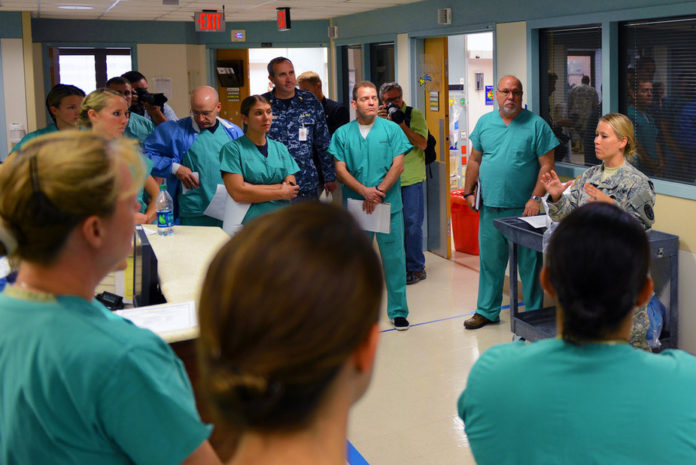
By Michael Tildesley, University of Nottingham; Katriona Shea, Pennsylvania State University, and Matthew Ferrari, Pennsylvania State University
As Arthur Conan Doyle said, “it is easy to be wise, after the event”. When it comes to infectious diseases, decisions about how to manage and contain them have been traditionally informed by prior experience and expert opinion.
However, each outbreak has idiosyncrasies. Every year presents a new strain of influenza; livestock production might change dramatically between outbreaks of foot-and-mouth disease; and Ebola had never before spread in West Africa. Given this, the best scientific information about the optimal course of action during an outbreak is likely to come from live analysis as it happens.
So decisions must be made in the face of uncertainty about how an outbreak will spread, relative to prior experience. A projection by the World Health Organisation in September estimated 20,000 cases by November 2 – 6,500 more than turned out – based on an “exponential growth phase”. As one health expert put it, the number appears to be “levelling off”. Projections aren’t easy and the 6,500 number is still hugely concerning – but what happens now?
You might also ask whether the goal of virus-control models in this setting is to predict the right number of cases or to recommend a course of action. Indeed, you would hope early projections of an outbreak would be ultimately incorrect, and that they might identify the best intervention with which to change the outcome.
Gathering control
One way of doing this is through structured decision-making and adaptive management. These both provide a mechanism for introducing control at the onset of an outbreak and then using information gained during it to determine the most effective long-term action.
This method, which we described in a new paper published in PLOS Biology, applies the mathematics of optimisation to the process for outbreak control. This borrows from similar applications in economics and natural resource management, where decisions – about investments, harvests, or conservation – must be made in the face of uncertainty about how the future will unfold.
A first step in the process is to formulate an explicit and quantifiable goal: for example “minimise cases of disease” or “minimise economic burden of an outbreak”. This forms the currency against which different outbreak scenarios can be evaluated. This step may seem simple but it can help limit conflict among experts. Take foot and mouth – while some might see rapid and severe culling as the best response for minimising the number of cases, others in industry would prioritise the cost of severe losses.
Scientific uncertainty can be represented in alternative models of an outbreak – and while the resulting projections may differ in the number of cases of disease, structured decision-making focuses instead on the decision that minimises that outcome. If all models recommend the same course of action to achieve the smallest outbreak, then the decision is clear – even though the models might differ as to how small the “smallest outbreak” will be.
But when various models differ on which interventions will achieve the desired end, then there is clear value in knowing which model is more likely to be correct. Economic theory describes this as the “expected value of information”; the value – with respect to the decision – of knowing which projection will be correct at the start.
Take foot and mouth disease
In a foot and mouth outbreak, uncertainty about how far and how fast infection may spread from farm to farm might be critical to decisions about bringing in pre-emptive culling or vaccination. In 2001, the disease entered the UK for the first time in more than 30 years. Around 800,000 cattle and 4 million sheep were either infected or culled in an effort to control the disease.
The outbreak was estimated to have cost around £5 billion (US$8 billion) to the UK economy as a result of livestock killed and losses to the tourism and export industries. As the outbreak progressed, it was determined that the initial control policies were not sufficient to control spread and therefore additional culling of farms in proximity to infected farms was introduced.
In our paper, we calculated that the value of resolving scientific uncertainty about the rate of spread for a new outbreak could have been as high as a £45-60m reduction in livestock losses.
This reduction was realised by optimising what would be done at the onset in light of the ability to change actions in the future if the unfolding outbreak demands it. So through computer simulation, we showed that while an inflexible strategy would recommend very severe culling from the start, an adaptive approach is optimal with limited initial culling, which is expanded only if the outbreak spreads rapidly.
The adaptive approach, of course, is never as effective as having a perfect prediction from the start. Perfect prediction is unlikely, but the adaptive approach for a foot and mouth outbreak could recover some 33% of the expected benefit of making decisions based on perfect predictions.
Lessons for Ebola
The current Ebola outbreak in West Africa has highlighted the challenges of bringing in control measures in the face of severe scientific and public health uncertainties. The various outbreak projections have ranged by orders of magnitude because we don’t yet know which processes will limit the epidemic. By comparing proposed interventions we can highlight which are expected to save the most lives.
The benefits of adaptive management are not limited to disease outbreaks. The method also has the potential to improve the effectiveness of routine vaccination strategies, disease surveillance and clinical trials. It also provides a way of introducing a strategy, modifying it if required, with the potential to yield significant rewards in terms of money or lives saved.
![]()
Michael Tildesley receives funding from the Biotechnology and Biological Sciences Research Council (BBSRC), the National Institutes of Health (NIH) and the Department of Homeland Security (DHS).
Katriona Shea receives funding from the National Institutes of Health (NIH) and the National Science Foundation (NSF).
Matthew Ferrari receives funding from US Department of Agriculture (USDA), National Science Foundation (NSF), National Institutes of Health (NIH), and the Bill and Melinda Gates Foundation.
This article was originally published on The Conversation.
Read the original article.




















